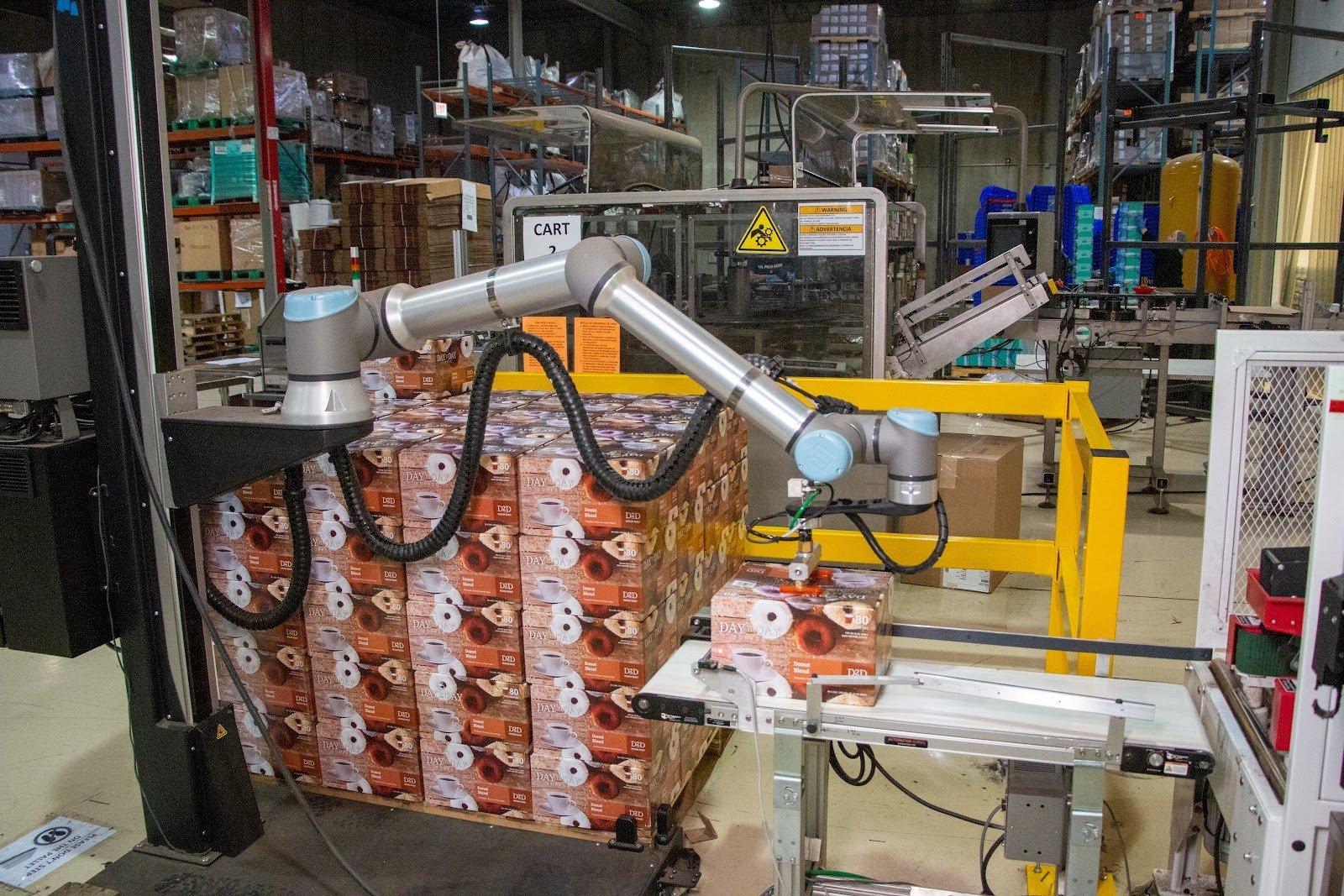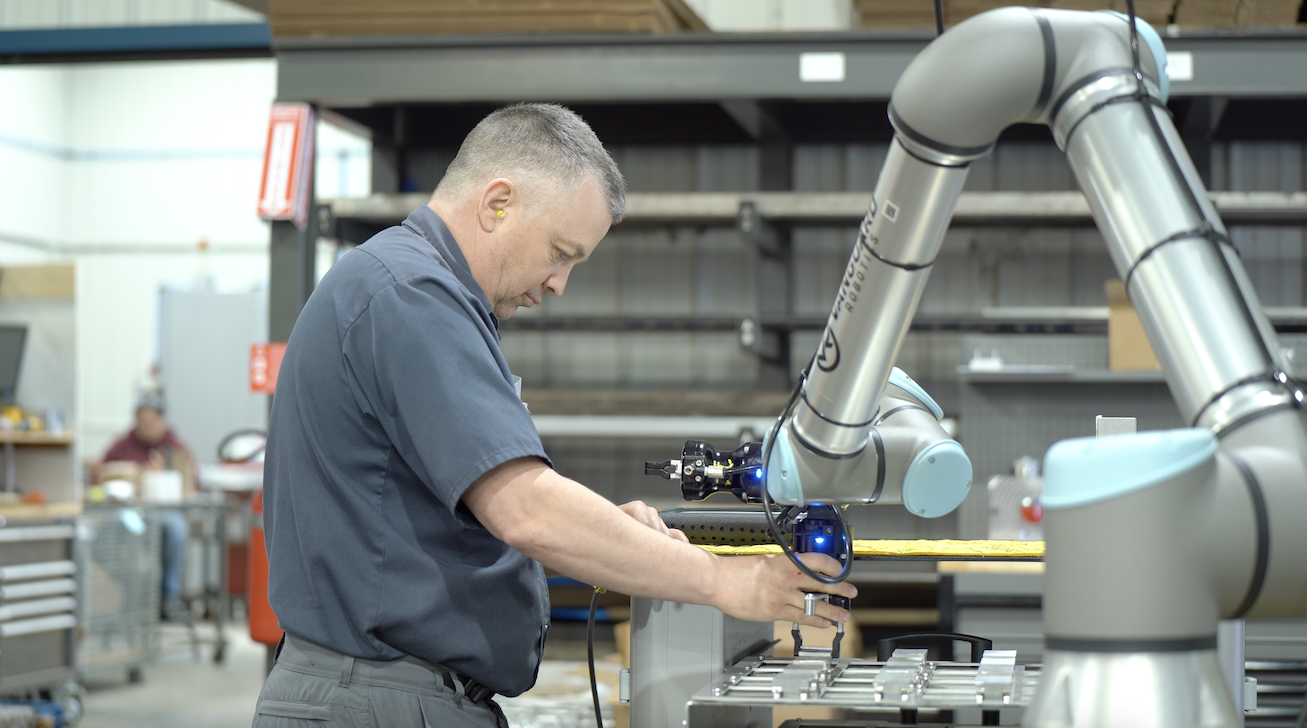Will Automation Solve the Manufacturing Labor Shortage?

Posted on Feb 12, 2024 in Manufacturing
9 min read time
Will Automation Solve the Manufacturing Labor Shortage? The answer is yes.
People want jobs that require something other than demanding, manual tasks. Repetitive, heavy lifting is both physically taxing and mentally unsatisfying. The aversion to labor-intensive jobs appears in economic statistics where 45% of durable good manufacturing positions remain unfilled in the United States, highlighting a significant gap between available opportunities and the workforce's inclination to accept injury-prone and hard work.

We know that not having enough people to fill roles is especially acute in manufacturing. People hired into manual roles, like palletizing, want to stay in that position for a short time. As a result, operations managers must continuously move or add people to address each process bottleneck, leaving them in a constant onboarding loop. There is a real cost to hiring workers. According to Zippia, hiring costs can be significant:
- The average cost to hire is $1,633 per job opening
- HR spends 15% of its budget on recruiting
- It takes an average of 39 days to fill a role
- Training costs businesses between $650-$1,100 per year
- It takes an average of 12 days for a new employee to reach their productivity potential
Amidst the hiring challenges and rising costs, it is clear that specific labor shortages must be addressed. This blog article explores the dynamics of manufacturing labor shortages, with a particular focus on palletizing operations. This blog will touch on palletizing and automation misconceptions, the role of manual labor, the disadvantages of having people palletize, review solutions for the manufacturing labor shortage, and look to the future.
A Look to the Future
The automation landscape is poised for significant shifts, as highlighted by Anders Beck, Vice President of Strategy and Innovation at Universal Robots. The demand for turnkey solutions is growing, requiring automation to be more user-friendly and accessible to smaller businesses.
Companies are pressed to find low-risk automated solutions that offer immediate cost savings. Solutions are expected to seamlessly integrate into existing processes without disrupting upstream and downstream operations. There is also a shift toward modular production using lightweight collaborative robots (“cobots”). These cobots continuously expand their payload and reach capabilities, providing adaptable and scalable solutions.
The shrinking labor pool and the manufacturing labor shortage have pressured companies to take another look at automated solutions. This is good, as automated solutions have improved significantly in the last few years. For example, collaborative robots have made robotic palletizers accessible to companies across varying levels of expertise. Businesses do not need internal resources with extensive technical expertise to operate these palletizing solutions.
Palletizing and Automation Misconceptions
The most essential part of production is shipping the product to the customer. As we know, palletizing shapes the supply chain efficiency and the profitability of the whole value stream. Packing a pallet is the final touch point before it enters the shipment and warehousing process.
What is Palletizing?Palletizing is a process of arranging and stacking products, either in their primary or secondary packaging, onto pallets. Pallets are secured to become one handling, transportation, storage, and distribution unit. Palletizing was a manual process until robotics could catch up with human capabilities. Today, turnkey palletizing solutions provide adaptable hardware and user-friendly software, enabling more manufacturers to invest in palletizing automation. |
Palletizing Automation Misconceptions
Despite advancements in robotic palletizing, many common misconceptions persist. This is understandable - advancements have accelerated over the past several years. Here are just a few of the myths that Robotiq comes across:
| Myth | Reality |
| Anyone who could automate their palletizing process has already done so. |
False. Many businesses (particularly small and medium-sized businesses) assessed available options in the past and decided not to invest. A few common reasons are:
Luckily, there are solutions on the market today that can address these barriers. These solutions are economical, easy to use and can be integrated without requiring extensive reorganization. |
| There are only a few automated solutions to choose from. |
False. There are many robots, software platforms, and integration companies on the market. However, the product solutions available are fragmented and pieced together. Solutions should be cohesive, which requires each business to find and piece together a solution. Fortunately, there are also turnkey options available that are the perfect balance between standardized and adaptable. Standardized for palletizing tasks, these solutions can be adapted to meet the unique requirements of each business. |
| All robotic palletizers require highly skilled labor to program and operate. |
False. Companies that incorporated robots over a decade ago will be astonished by the advancements in software. For instance, turnkey solutions feature preprogrammed, user-friendly software that can be mastered within hours. |
| Automated palletizing solutions are only viable for large enterprises to achieve a return on investment. |
False. Small and mid-sized businesses (SMBs) can achieve their ROI targets when matched with the right palletizing solution. For example, selecting a turnkey solution can accelerate the ROI timeline. Turnkey solutions provide an affordable solution that can be stacking pallets within a shift. The palletizing case studies on our website show a few ROI examples, including:
|
| A palletizing robot requires a sizable footprint and large overhead space. |
False. Collaborative robot solutions require significantly less floor space compared to traditional robot solutions. Traditional industrial robot palletizers are large and require safety barriers to keep them away from people. Installation necessitates the factory floor to be reconfigured or a separate, centralized palletizing location to be created. |
| A palletizing robot always requires a fenced-off safety area. |
False. Not all palletizers have to work inside of a barrier. Collaborative robots are designed to prioritize safety and are intended to work alongside people. Equipped with force sensors, these robots can stop quickly to avoid a collision. While a safety assessment is required for every installation, there are applications where the cobot palletizer will be working near people. |
The Role of Labor in Palletizing Operations
People want to avoid putting boxes on pallets. So why are we still dependent on this manual process? It stuck around for two main reasons:
- Adaptability: Human workers possess the ability to adapt to different case weights, dimensions, cycle time, and other real time factors.
- Flexibility: Humans have dynamic problem-solving skills and can adjust in real-time.
However, there are a few disadvantages to relying on people to palletize products.
The Disadvantage of Humans Palletizing
Tall Pallets
International shipping costs remain elevated and factors like conflicts in shipping routes are expected to keep it there. To mitigate these higher costs, manufacturers are increasing the quantity of product that is on each pallet. This includes maximizing the use of vertical space.
While manufacturers increase the height of pallets, this practice comes with an increased risk of injury for employees. As the weight and height of the boxes increase, it becomes challenging to stack them manually, especially when placing boxes overhead.

Safety and Quality
Loading boxes on a pallet can be a monotonous task. Boxes can be heavy, especially in food production. Picking boxes off a production line means that packers must move products below and above their waist, leaving them prone to repetitive strain injuries (RSIs) and other safety risks.
As manufacturers detect bottlenecks in production, they will move people around in the value stream. Moving people to different tasks can be good for morale. However, a greener person moves in when a trained person moves to another area in the process. This person has to learn dozens of pallet configurations quickly. Manufacturing companies may also have thousands (or hundreds of thousands!) of SKUs to manage. The inexperience of the palletizing person combined with product complexity increases the risk of making mistakes or taking safety risks.
Quality is essential in every industry. However, the consequences of making a mistake are higher in pharmaceutical, food production, or beverage distribution industries. For companies with hundreds of SKUs and dozens of pallet configurations, this means constant training and leader oversight to prevent mistakes. This is time-consuming for tenured operators and factory leadership.
Solutions for the Manufacturing Labor Shortage
Workers are less concerned about being replaced by automation. Instead, they expect automation to assist them in their day-to-day job. More than 80% of workers want investments in automation to help them with their tasks. Deploying the appropriate automated solution can augment the value contributed by human workers:
- Adaptability: Flexible software should allow quick changeovers and new programs. For example, Robotiq uses assistant tools and simple configurations so switching to a different setup is easy. Turnkey solutions make creating a pallet layout easy. Additionally, the Robotiq Palletizing Solution automatically generates optimized trajectories for the cobot, reducing cycle time and making the operator’s job easier.
- Flexibility: Robot palletizers can adjust for case weight, dimensions, and cycle times. The Robotiq Palletizer Simulator demonstrates how straightforward it can be to configure a palletizing robot.

Conclusion
Will automation solve the palletizing worker shortage? Here at Robotiq, we believe that automating these types of tasks (especially ones with a risk of injury) is the most straightforward way to solve this problem. Automation presents an opportunity for a business of any size to save time, reduce costs, and maintain employee well-being.
The labor shortage numbers and worker turnover rates prove that people do not want to work in repetitive, low-skill jobs. We found that all manufacturers, even the small to medium-sized ones, can use turnkey solutions to automate their palletizing process. Manufacturers open the door to empower individuals, enhance productivity, and foster adaptability by incorporating a cobot palletizer at the end of the production line.
Make a Move
You could be fully automated by next month. Robotiq provides a range of palletizing solutions, ensuring there is an option readily available that meets your needs.
Schedule time with an automation expert to discuss your requirements, evaluate feasibility, and estimate ROI.





Leave a comment